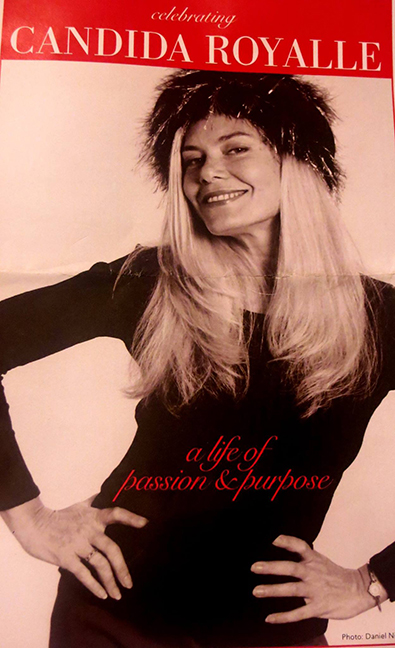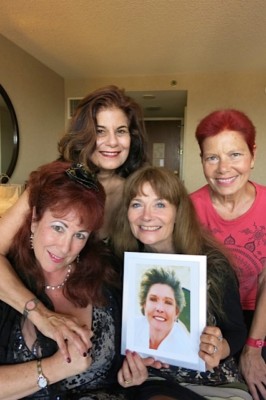by Nancy Jainchill
Originally published in entropymag.org January 2016
 “Wear red,” we were told. The occasion was the memorial and celebration of Candida Royalle, the “Grace Kelly of porn,” who not only was an iconic sex goddess—beginning her career in such films as “Wine Me, Dine Me, 69 Me—but also, in her later years, was an invited speaker at the American Psychiatric Association and the Smithsonian Institute. Within a decade of starring in “Hot and Saucy Pizza Girls—We Deliver,” she put women on top, straddling the porn industry and feminism by founding her own sex-positive porn company and later receiving an honorary doctorate in human sexuality. When Candida died from ovarian cancer September 7 of this year (2015), she left a unique legacy in the history of the adult film industry, and one that inspired over 300 people to arrive wearing her favorite color—from hair on fire, to sequined jackets and clinging red dresses, to my fire engine red cowboy boots.
“Wear red,” we were told. The occasion was the memorial and celebration of Candida Royalle, the “Grace Kelly of porn,” who not only was an iconic sex goddess—beginning her career in such films as “Wine Me, Dine Me, 69 Me—but also, in her later years, was an invited speaker at the American Psychiatric Association and the Smithsonian Institute. Within a decade of starring in “Hot and Saucy Pizza Girls—We Deliver,” she put women on top, straddling the porn industry and feminism by founding her own sex-positive porn company and later receiving an honorary doctorate in human sexuality. When Candida died from ovarian cancer September 7 of this year (2015), she left a unique legacy in the history of the adult film industry, and one that inspired over 300 people to arrive wearing her favorite color—from hair on fire, to sequined jackets and clinging red dresses, to my fire engine red cowboy boots.
As part of the two-hour celebration at Judson Memorial Church, a video montage was played which avoided the hard core activities that were part of Candida’s early career. The clip from Hot and Saucy Pizza Girls showed Candida before she got naked and saucy. Her long chestnut hair flying, she filled the screen balancing on a skateboard to the background music: “they satisfy you, these pizza girls.”
From a childhood of Brownie troops and Girl Scouts in New York City, to her early training in the performance arts, Candida moved out to San Francisco and was initiated into the world of pornography in the early1970s. Answering a call to do nude modeling, her career as a porn star was launched. At the same time that she was active in the women’s movement of the late ’60s and early ’70s, she was stripping, hooking up with some of the original members of the Cockettes including the late Divine to create avant garde jazz and theater productions. The women’s movement was all about choice and while some women chose to cast off their aprons, she cast off everything.
Just a few years earlier, I’d made my own debut into the world of adult entertainment, but unlike Candida I never found my niche. Although it seems I landed on the wrong set–one much less professional than where she found herself—I was in porn (back in the day of 8mm reels) and danced naked on Broadway in San Francisco’s North Beach at about the same time that her career was taking off. Only a few years older, I was struggling to figure out the relationship between personal sexual freedom and feminism. Unlike Royalle, I couldn’t smoke enough marijuana to make me relax during the filming. Instead, lying with the hot lights directed at me I thought about my mother, whether they’d use my real name on the credits, and what my boyfriend must be feeling. And slithering across the dance floor of a North Beach nude bar to Percy Sledge, you couldn’t convince me that any man loved any woman anyhow. I don’t know how Candida managed to enjoy herself—her motivation must have been more urgent than rent money.
Entering the world of erotica, she performed in about twenty-five adult feature films before deciding to go into business for herself, and simultaneously to transform the industry and its message. She had fallen in love and married, and perhaps her career change was precipitated by her life change. Candida became the first feminist director/producer of women-friendly pornography—insisting on safer sex and producing hard core porn that was also about love—taking on the male-dominated adult film world. In 1984 Femme Productions was started; her ground-breaking, New York-based, woman-focused film studio, that produced films with women as equal partners in the erotic act, their pleasuring at least as important as a man’s. Pornography was a means for promoting sexual freedom and sexual knowledge, for making erotica based on female desire. Competing in a man’s world, Candida countered the misogynist message conveyed by unrealistically perfect bodies that could be so damaging to a woman’s self-esteem and sexual life. Her stars didn’t have 36-24-36 bodies with satin skin.
The status of pornography in our Protestant-based culture is complex for sure. Although it has a widespread audience, it remains largely clandestine, something not talked about freely at most mainstream social gatherings. Yet, Candida managed to break through barriers and for her work promoting women’s sexual equality on film, in relationships, in bed, in life—she was awarded an honorary doctorate in Human Sexuality from the Institute for the Advanced Study of Human Sexuality in 2014.
Candida Royalle wasn’t her real name—it was Candice Vadala—and the assemblage of three hundred or more people at the memorial I attended was dense with akas. She’d had a potpourri of assumed names (Candice Ball, Candice, Candice Chambers, Candace DeCarlo, Sharon Lucas, Bettina Mia, Mary Pearson, Cynthia Pleschette, Candida Royal, Candida Royale, Candice Royalle, Candita Royalle, Kathy Silverman, Jeanne Toller), was still using Candice in the 1976 film, Honey Pie, but by 1979 but apparently had assumed the identity of Candida Royalle. Why Candida? The best I can figure out is that she related to the tune of that name sung by Andy Williams, among others.
Candida was a founding member of Club 90, the first porn star support group. With her wild hair a lipstick red for the service and two of the original five members of the group beside her at the podium, Annie Sprinkle (aka) captured the spirit of Club 90 which continued to meet for 32 years, raising female consciousness in the exploitive porn industry: “We were the original Sex and the City Girls before there was Sex and the City. … Candice you take our deepest secrets to your grave. And know that most of our wildest dreams have come true.”
The surviving original Sex and the City girls:

A feeling of sisterhood and personhood permeated the evening, as strong as any that I’d experienced in the feminist gatherings of the earlier years. Candida’s sisters evidenced a comfort with their sexuality that was enviable, and while they’ve pretty much aged out of the industry, they continue to work in allied fields, confirming their commitment to the message of their earlier lives. It was clear that the sense of family Candida helped create in what at first was a small band of outsiders—renegades—persists today. A family that was perhaps created in response to the loss of families of origin, as Royalle had little relationship with her Italian family that was so important when she was growing up: “…an unavoidable consequence of choosing to break the rules and live according to my own beliefs.”
Royalle’s coming of age occurring during the 1960s and 1970s, was a time when women were attempting to redefine the role of the female in the new world order. As her story reveals, in some ways, she was more successful than many of us. She understood the importance of self-acceptance and the need for women to understand and acknowledge their sexual needs and desires, which were just being recognized during those years, and which remain a challenge for many even today. Not only did she become a star, Candida revolutionized the adult entertainment industry for women, both as participants and as observers. Nonetheless, her work is not without controversy—her critics say that she as much as anyone else has been in the business of eroticizing and taking advantage of women’s inequality. Looking into her own soul, questioning her involvement with the industry, she determined that there was nothing bad about what she or her sisters did, yet she knew that they’d be judged even while millions of people are consumers.
Why was she able to throw off the sheets while I hid beneath them? Those years, when the message was more ambiguous, accepting my sexuality wasn’t easy. My attitude toward pornography has changed since I’ve come to learn about Candida, and I’m finally getting more comfortable with my own story. I came home from the memorial with Rites of Passion (2004), a Femme Productions film, which I haven’t watched yet—I’m waiting for the right moment. At the memorial I witnessed Candida Royalle’s world, reflecting a fluidity and acceptance of sexuality begun in the 1970s and 1980s when she and others were initiating a revolution. Her life affirmed her perspective: “that there is no wrong way to be a woman.”
The New York Times obituary included a statement she made in 2012 which echoed the ongoing confusion that prevails in our society toward sex and sexuality: “Perhaps if we weren’t still so consumed with guilt and shame about sex, neither watching nor performing in these films would carry the weight it does,” she replied. “But then, perhaps we wouldn’t be so interested in them, either. If the fruit were not forbidden, would anyone care to take a bite?” Porn isn’t dead—nor is Candida. Nor is the need to understand the complexity of porn and its influence on our social sexuality, and of women’s role in the adult entertainment industry.
An animal lover, Candida was portrayed as the Bridget Bardot of Long Island in her opposition to deer hunting, and with her passing as “a white cat in the sky, like one of her beloved cats: white and gorgeous, and she’s sitting there in the sun…and she’s licking herself and she’s preening herself… and you know that there are claws and teeth… and that there’s a playful kitten that wants to run around… and you just want to pick her up and pet her and love her forever, . . . .”



